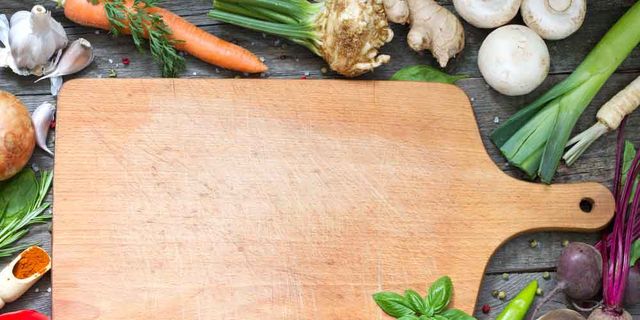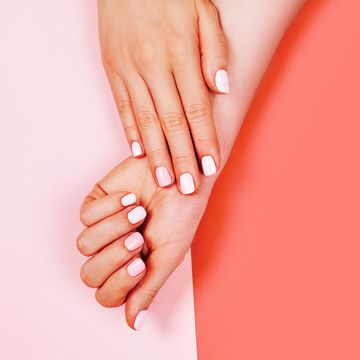You use a glass board—ever.
 dmitriy podlipayev/shutterstock
dmitriy podlipayev/shutterstockIt's true that glass cutting boards are more resistant to stains and odors. But that hard surface will quickly dull your knife's blade. It could also put you at higher risk for an injury, since the slick surface can cause your knife to slip. A better option? Stick with boards made of wood or plastic. The more forgiving surfaces will keep your knives sharp longer, and they'll help keep your fingers out of harm's way. (Research shows that wood may be less likely to harbor bacteria. But plastic boards are still safe as long as they're cleaned thoroughly.)
MORE: 19 Kitchen Tools Every Clean Eater Needs
You use a tiny board.
 evgeny karandaev/shutterstock
evgeny karandaev/shutterstockA cute little cutting board might take up less space in your kitchen and be a little easier to clean. But the smaller surface area means that food will constantly be sliding off your board. Plus, your knife won't have enough room to move back and forth—putting you at a higher risk for getting hurt. Save yourself the trouble and go for the bigger board.
MORE: 8 Mistakes You're Making Every Time You Wash Dishes
You're not using a separate board for meat.
 alexey borodin/shutterstock
alexey borodin/shutterstockIt's no secret that raw meat, poultry, and fish can harbor bacteria like
E. coli and
Salmonella, which can make you sick. But when you use just one cutting board for both meat and veggies, the juice from the former is more likely to contaminate the latter. So keep a separate board that's just for animal proteins (buy one in a different color so it stands out), and clean it with hot, soapy water after each use.
Advertisement - Continue Reading Below
You don't use a separate board for someone with food allergies.
 wustrow/shutterstock
wustrow/shutterstockCross-contamination isn't just a risk for meat. It can also be a problem when you're prepping food for someone with an allergy, since even a cutting board that looks clean could still harbor traces of an allergenic food. Consider investing in a separate board if you regularly cook for someone with an allergy. If you're using your regular board, take steps to thoroughly wash and sanitize it. (Use chlorine-based sanitizers for plastic boards and quaternary ammonium sanitizers like Mr. Clean for wooden boards, recommend food safety experts at North Carolina State University.)
You stick your wooden board in the dishwasher.
 africa studio/shutterstock
africa studio/shutterstockIt's fine to put that plastic cutting board in the dishwasher. But the high heat can cause wooden boards to warp or crack, so it's better to wash those by hand. (Avoid soaking wooden boards, which can also cause warping or cracks.) Plain old soap and warm water will usually do the trick. But if you're dealing with stains or strong odors, you can get rid of them by sprinkling your board with baking soda and rubbing the board with half of a sliced lemon.
MORE: The Germ Bomb That's Lurking In Your Kitchen
You're not drying your board thoroughly.
 stephen kirsh/shutterstock
stephen kirsh/shutterstockA damp board and minimal air circulation sets the stage for yucky bacteria growth. Instead of placing your freshly washed cutting board right back on the counter, you're better off letting it hang out on a dish rack for a little while. That way, it'll dry completely.
Advertisement - Continue Reading Below
You're not oiling wood boards.
 dusan zidar/shutterstock
dusan zidar/shutterstockOver time, all that
washing with soap and water can cause wooden boards to dry out and crack or split. But rubbing the surface with food-grade oil (like mineral or
olive oil) keeps it from drying out, so your boards last longer. You don't have to do it every day or after every time you clean your board. Once a week—or even once a month—is enough to make a difference.

Marygrace Taylor is a health and wellness writer for Prevention, Parade, Women’s Health, Redbook, and others. She’s also the co-author of Prevention’s Eat Clean, Stay Lean: The Diet and Prevention’s Mediterranean Kitchen. Visit her at marygracetaylor.com.
Advertisement - Continue Reading Below
Advertisement - Continue Reading Below
Advertisement - Continue Reading Below





















